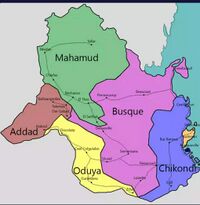Kamalbia
Federal Republic of Kamalbia | |
|---|---|
| Location of Kamalbia (dark green) in Teudallum (dark grey) Location of Kamalbia (dark green) in Teudallum (dark grey) | |
| Demonym(s) | Kamalbian |
| Establishment | |
• Settled by Exponent | 1548 |
• Made an earldom of Cadenza | 1620 |
• Ceded to Berique | 1814 |
| Area | |
• Total | 1,956,600 km2 (755,400 sq mi) |
| Population | |
• Census | 14,290,614 |
• Density | 7.3/km2 (18.9/sq mi) |
| GDP (PPP) | estimate |
• Total | Tuppence |
| Time zone | (UTC) |
Kamalbia (pronounced /ˈduːdɜr/), officially the Federal Republic of Kamalbia, is a country on the west Astyrian continent of Teudallum. It borders the Dangish Empire and Terre Azure to the north, Cassonne to the southwest, Heideland and Caranad to the west and the Beriquois overseas territory of Equinoxiale to the east.
Following the 2014 Multinational Invasion of Kamalbia, the Federal Republic of Kamalbia was torn in two, ceding much of its north, west, and southwest to become a rump state commonly referred to as South Kamalbia.
History
Prehistory
Antiquity
Middle Ages
Colonial Era
Southern Kamalbia was settled as a colony of the Exponential Empire in the mid-sixteenth century. It was seized by Cadenza during the War of the Magpie and the Dragon in the early seventeenth century and became a major source of diamonds for the nascent Cadenzan Empire. It was ceded to Berique at the end of the Bernadottic Wars. Kamalbia gained independence later on.
Independence
Kamalbian Edenic Soomaraaq
After nearly two years of deadlock dur to clan and tribal differences amongst members of the transitional government, internal strife and dissatisfaction with the transitional leaders began to fuel unrest throughout the country.
On September 2, 1970, a group of army officers centered around Rashiid Galbeedi, an influential military officer, seized the opportunity to lead a coup and overthrew the transitional government in a largely bloodless coup. During the coup, many government officials simply surrendered, believing Galbeedi represented a more promising future for Kamalbia than the mismanaged transitional democracy could provide.
Under Galbeedi’s rule, Kamalbia moved to nationalize hundreds of Beriquois companies and the Beriquois population was expelled to neighboring Equinoxiale and Terre Azure. Utilizing the new wealth brought about from nationalizing these industries, Galbeedi began instituting an array of new social programs designed to uplift the Kamalbian population. The country also began drastically ramping up the size of its military at this time as well.
Seeking to capitalize on his pan-Edenic goals, Galbeedi also began heavily and openly supporting various factions in the Hesperidesian Revolutions, portraying the groups as brother Edenic people rising up against their colonial oppressors.
In retaliation, the Empire of Exponent ordered a massive naval and air bombardment of the Kamalbian capital, Fesebunuill, as well as the coastal cities of Ceel Hafun and Villecause on November 3, 1977. Exponential aircraft also struck targets in Bur Burawa, Eylil, and Beaucaut as well. The bombardment, known as Operation Ira Draconis, severely damaged the legitimacy of the Galbeedi regime in the eyes of many Kamalbians, and led to an attempted coup in 1978.
The coup failed, but the threat of rising discontent pushed Galbeedi to enact a series of reforms in 1980 meant to push power into local "People's Councils," to provide the appearance of grassroots control. In reality, however, Galbeedi remained the ultimate authority in the country.
In 1999, amidst a significant economic downturn in Kamalbia, the First Kamalbian Civil War erupted out of escalating protests in Ceel Hafun and Bur Barawa. These protests exploded into a multi-faction armed conflict, culminating in the capture of Fesebunuill by forces loyal to General Ladan Busque and the assassination of Galbeedi on June 12, 2003, effectively bringing an end to the Kamalbian Edenic Soomaraaq.
Warlord Era
After the United Kamalbian Congress forces under General Ladan Busque took control of Fesebunuill, the UKC began attempting to re-establish themselves as the de jure government of Kamalbia, re-establishing the shortlived national name of the Federal Republic of Kamalbia.
Despite the UKC occupying the capital and a substantial part of central Kamalbia, however, opposition forces refused to cooperate with the new regime. In the south, forces loyal to General Gyassa Chikondi maintained a stronghold, while in the north the troops of the Kamalbian People's Coalition led by Colonel Samatar Mahamud took control over a large portion of territory. To the east, the Edenic Freedom Party under Rashiid Hadad, while in the west troops loyal to Gani Suleman took control of the city of Villecause and its environs.
Amidst all this, the nation of Oduya also broke away, propped up by funds and mercenaries from the Griffincrest Corporation.
Astyrian Liberation Army
The Astyrian Liberation Army (ALA) was formed in the initial uprisings against Galbeedi in 1999, and quickly took advantage of the relative lawlessness of the factional fighting to develop bases of operation throughout Kamalbia.
